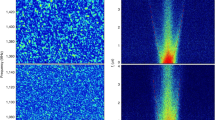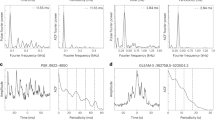Abstract
AN elegant mechanism to explain the high velocities of pulsars has been proposed by Harrison and Tademaru1,2. Based on the observations that the interpulses seen in some pulsars are located asymmetrically between the main pulses, they assume that pulsar magnetic fields arise in general from off-centred dipoles. The asymmetric radiation reaction produced by such an inclined off-set rotating dipole accelerates the pulsars in a direction parallel to their spin axes and gives the observed velocities. Any verification of the above hypothesis hinges on the possibility of determining, and comparing, the angle projected by the spin axis on the sky S with the observed direction of motion of the pulsar V. According to Harrison and Tademaru's model1,2, these directions would coincide (V = S). We wish to point out here that a measure of the spin axis projected direction is given by the intrinsic angle of polarisation of the radio emission at the centre of the integrated pulse profile, and that these polarisation data do not support the hypothesis in most cases.
This is a preview of subscription content, access via your institution
Access options
Subscribe to this journal
Receive 51 print issues and online access
$199.00 per year
only $3.90 per issue
Buy this article
- Purchase on Springer Link
- Instant access to full article PDF
Prices may be subject to local taxes which are calculated during checkout
Similar content being viewed by others
References
Harrison, E. R., and Tademaru, E. P., Nature, 254, 276 (1975).
Harrison, E. R., and Tademaru, E. P., Astrophys. J., 201, 447 (1975).
Weiss, E. R., Astrophys. J., 190, 331 (1974).
Tsarevsky, G. S., Astrophys. Lett., 10, 71 (1972).
Trimble, V., IAU Symp. No. 46, 12 (1970).
Manchester, R. N., Taylor, J. H., and Van, Y. Y., Astrophys. J., Lett., 189, L119 (1974).
Anderson, B., Lyne, A. G., and Peckham, R. J., Nature, 258, 215 (1975).
Rees, M. J., and Gunn, J. E., Mon. Mot. R. astr. Soc., 167, 1 (1974).
Disney, M. K., Astrophys. Lett., 9, 9 (1971).
Manchester, R. N., Astrophys. J., 172, 43 (1972).
Komesaroff, M. M., Nature, 225, 612 (1970).
Manchester, R. N., and Taylor, J. H., Astrophys. Lett., 10, 67 (1972).
Komesaroff, M. M., Morris, D., and Cooke, D. J., Astrophys. Lett., 5, 37 (1970).
Morris, D., Schwarz, U., and Cooke, D. J., Astrophys. Lett., 5, 181 (1970).
Manchester, R. N., Astrophys. J. Suppl., 23, No. 199 (1971).
Manchester, R. N., Astrophys. J., 188, 637 (1974).
Van den Bergh, S.,, Astrophys. Lett., 16, 75 (1975).
Radhakrishnan, V., and Cooke, D. J., Astrophys. Lett., 3, 225 (1969).
Author information
Authors and Affiliations
Rights and permissions
About this article
Cite this article
MORRIS, D., RADHAKRISHNAN, V. & SHUKRE, C. Test of pulsar acceleration mechanisms. Nature 260, 124–126 (1976). https://doi.org/10.1038/260124a0
Received:
Accepted:
Issue Date:
DOI: https://doi.org/10.1038/260124a0
This article is cited by
-
Spatial velocities of pulsars
Journal of Astrophysics and Astronomy (1990)
-
The acceleration of pulsars—a new test
Nature (1989)
-
Astrophysics: Origins of the magnetic fields of neutron stars
Nature (1984)
-
On the origin of pulsar velocities
Nature (1983)
-
Properties of slowly rotating helium II and the superfluidity of pulsars
Journal of Low Temperature Physics (1980)
Comments
By submitting a comment you agree to abide by our Terms and Community Guidelines. If you find something abusive or that does not comply with our terms or guidelines please flag it as inappropriate.



